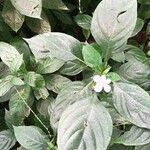Subshrubs to 80 cm tall, branched. Stems subterete, coarsely fulvous strigose. Petiole 0.7-2.5 cm, brownish yellowish strigose; leaf blade elliptic to ovate, 5.5-15 × 2.2-5.5 cm, both surfaces fulvous strigose especially along veins, secondary veins ca. 7 on each side of midvein, base cuneate and decurrent onto petiole, apex acute. Flowers in axillary and terminal dense spikes to 5 cm; bracts oblong to elliptic-oblong, abaxially shortly strigose along veins, apex sharply acute; bracteoles elliptic, ca. 1.2 cm, 1-veined, margin ciliate, apex acute. Outer calyx lobes purple, ovate, ca. 3.2 × 1.8 cm, base rounded, margin subentire to dentate, apex acute; inner calyx lobes yellowish brown, lanceolate, ca. 1.5 × 0.2 cm, both surfaces strigose, apex acute. Corolla purplish red, 5-6 cm; tube basally cylindric for ca. 3.7 cm, throat ca. 1.2 cm; lobes obovate-oblong, ca. 2 × 1-1.5 cm, subequal. Stamens 4; filaments basally pilose, longer pair ca. 1.3 cm with anthers ca. 5 mm, shorter pair ca. 3 mm with anthers ca. 1.5 mm; staminode 1. Ovary ovoid, ca. 3 mm; style ca. 2.5 cm. Capsule ellipsoid, 1.4-1.8 × ca. 0.5 cm, glabrous, shining, 4-seeded. Fl. Nov, fr. Feb. 2n = 40.
More
A shrub. The stems are swollen just above where the leaves are attached. The stems are flattened and have light brown hairs. The leaves are 13 cm long by 6 cm wide. The flowers are in a compact spike in the axils of the leaves. There is a single leaf like bract around each flower. The flowers are bluish. The fruit is an oval capsule. There are 1 or 2 seeds that have hooks.

